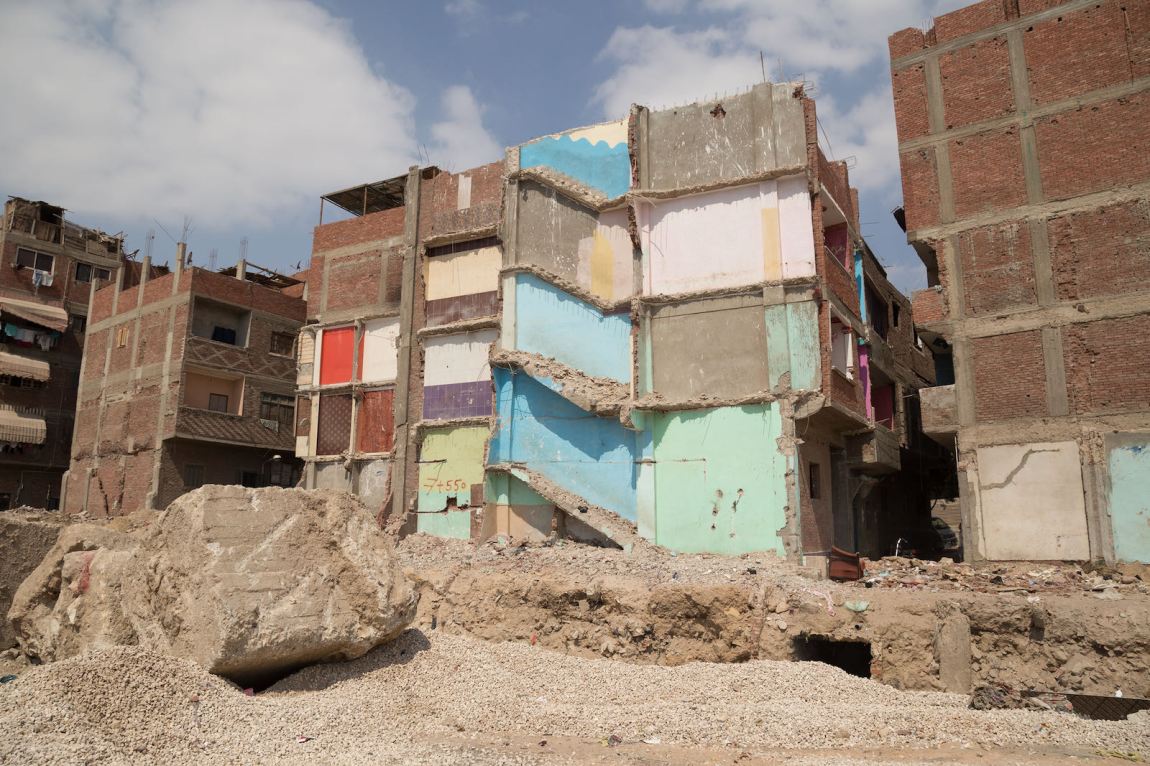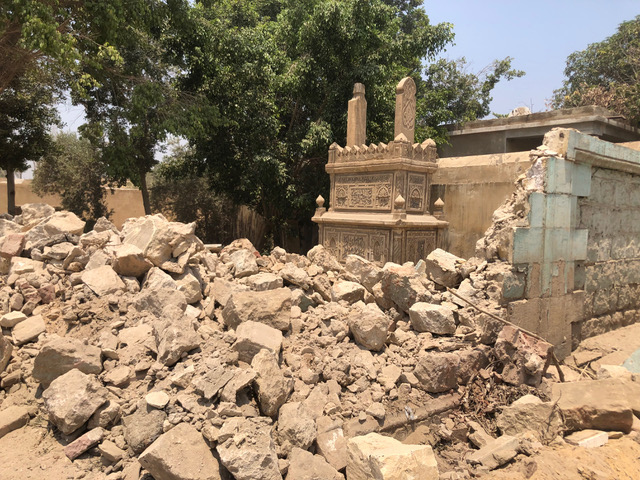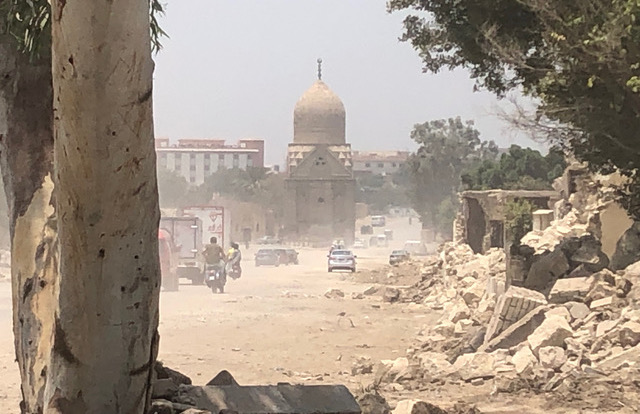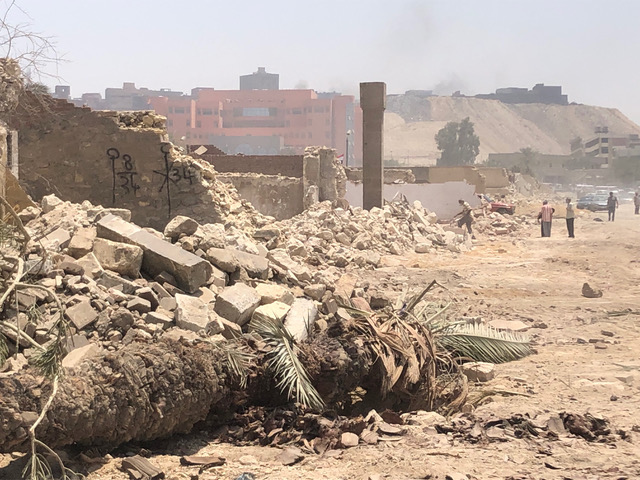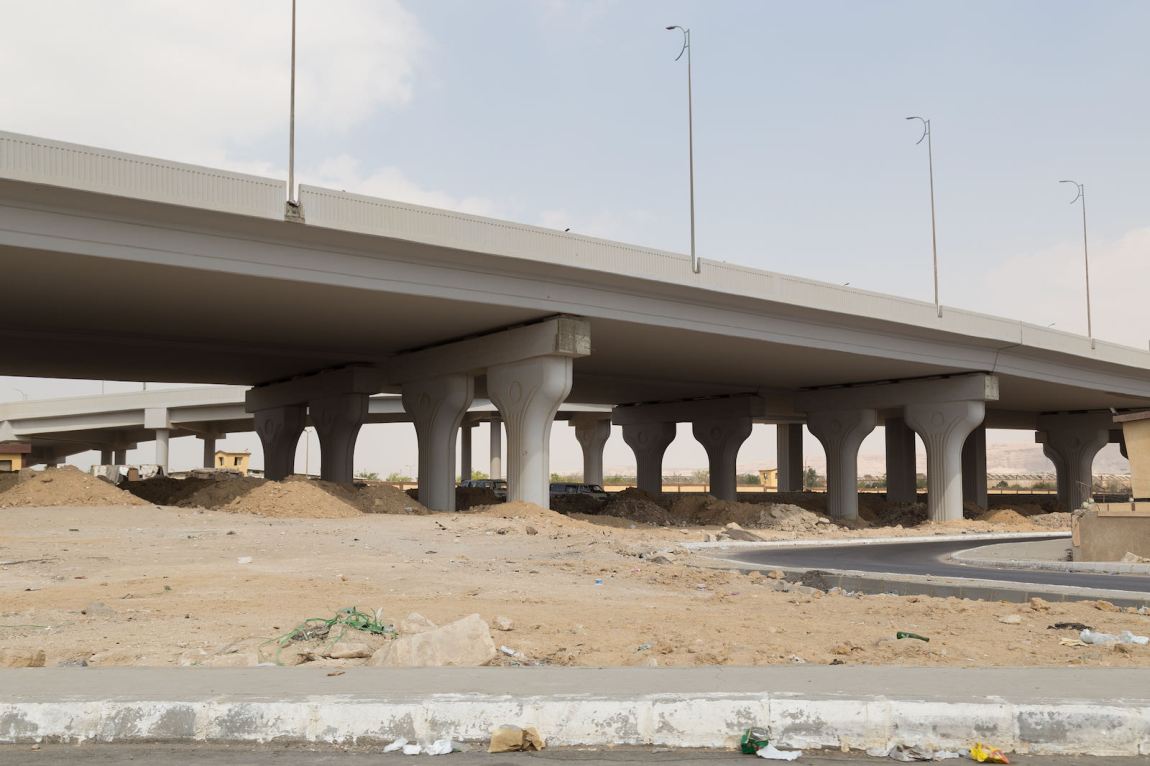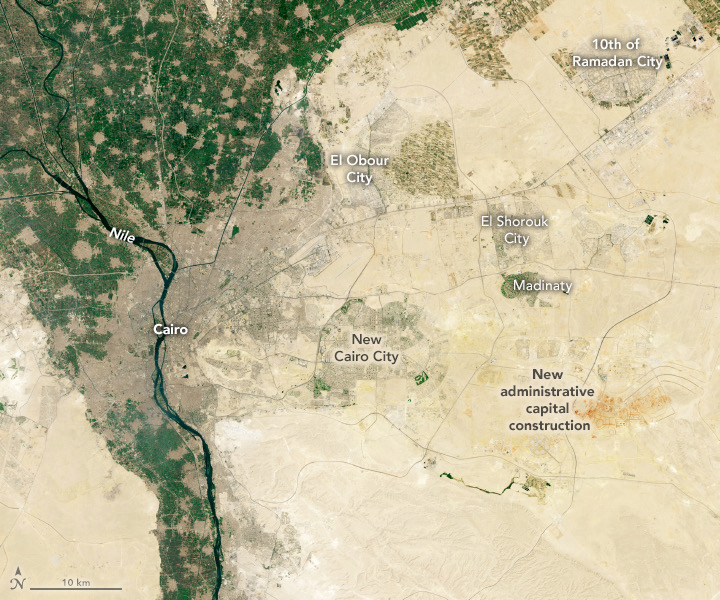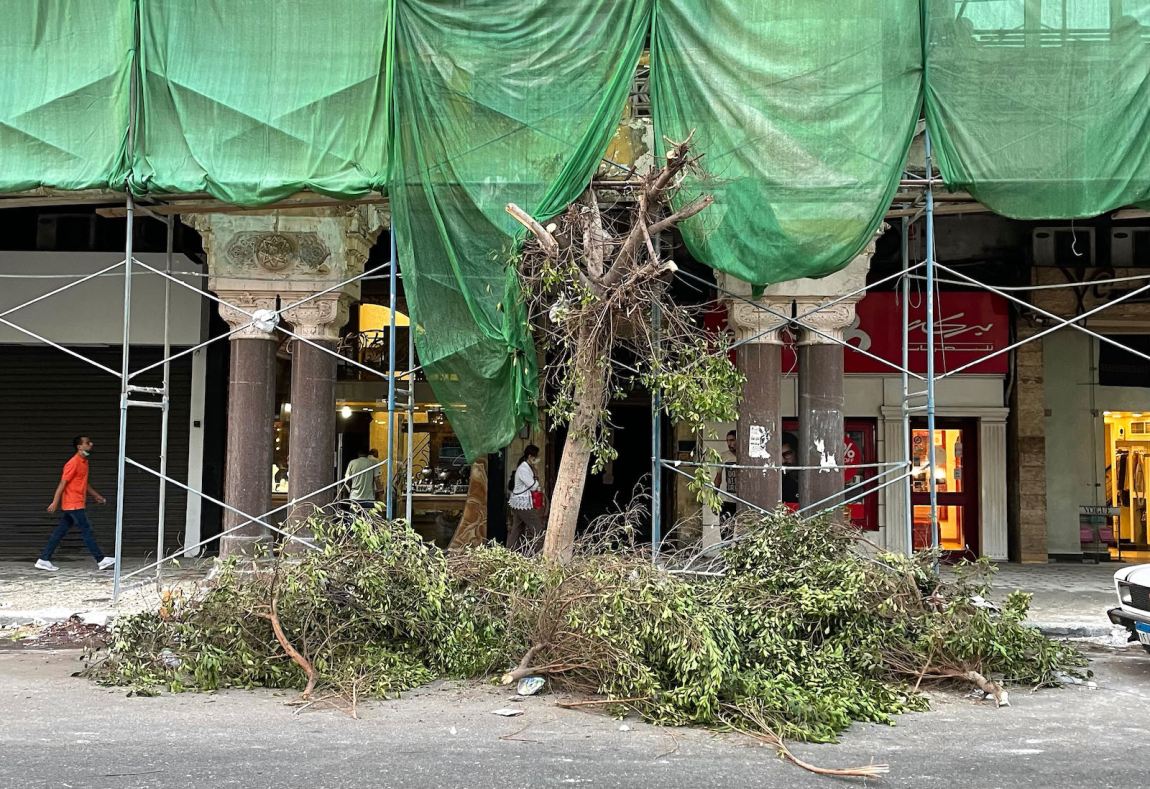I have the sense, on many days, that my city is at war with itself. Not in the visibly armed meaning of battle, but an insidious crusade of ideology and will. Such is President Abdel Fattah el-Sisi’s plan to make over Egypt’s capital, a neo-pharaonic campaign so ludicrous it would be dismissible if it didn’t actually involve the pillaging of Cairo as it has existed, in parts, for centuries, erasing whole swaths of the city’s urban heritage and ravaging everything in its path, from the living to the dead.
This might sound like an exaggeration for effect, but the destruction is that dire, and that extensive. Thousands of buildings have been bulldozed, most of them residential, people’s homes. Across the city, several thousand acres of apartment blocks—representing lifetimes of people’s savings, family history, and memories—reduced to rubble. One of the first neighborhoods to go, a district dating in part back to the 1400s known as Maspero, only minutes from Tahrir Square, comprises some eighty-five acres of land that was once home to 18,000 residents; it was razed on the pretext of being an “informal settlement,” the modern planners’ euphemism for slum. Yet, anyone surveying the site before its buildings were demolished would have observed that even though some of them were in fact illegally built in more recent years, the majority were well-preserved, opulent art deco buildings dating back to the 1920s, with finely carved stone corbels on their facades and grand marble staircases that led to palazzo-style apartments with stucco-molded ceilings more than twelve feet high.
Neighborhoods are still being demolished with wrecking balls all over the city. I regularly drive on the “ring road,” a forty-mile highway that encircles Cairo, and over the past year have witnessed the disembowelment of the buildings on either side—the interiors of sitting rooms, bathrooms, kitchens exposed to the air as they are brought down. Although these buildings were hastily constructed on agricultural land, likely enabled by bribes to local municipalities to turn a blind eye to their zoning violations, these blocks nevertheless provided homes to tens of thousands of Cairenes. If I am stuck in traffic, there’s time to take in their cross-sections; hardest to look at are what must be children’s bedrooms, painted in bright shades of pink or green and blue. In these crowded poorer neighborhoods, those rooms rarely had much of a view—the polka dots and Disney characters on the walls were often all those kids had to enjoy.
Even Cairo’s dead have not been left in peace. The government has demolished hundreds of burial plots in the historic City of the Dead, just east of the city center. Some of the tombs and ornate mausoleums date back to the Mamluk and Ottoman periods; others are regular family plots, belonging to people like us. Earlier this year, just after the destruction commenced, some friends asked me and my brother to check on their family’s site; another had called us, worried about her grandmother’s grave. On our visit, I saw relatives wailing as they watched family tombs go under the bulldozer’s blade, as surveyors directed the crew—another few feet here, another few there—in callous desecration. Human remains were unearthed inadvertently in the process that day, some just freshly laid to rest.
The pattern of this destruction can be understood—in a purely technical sense—by mapping the highways and bridges, and extra streets and expressway lanes, that have taken the place of tombs, trees, and homes. The construction signage for the government’s General Authority for Roads, Bridges, and Land Transport is everywhere in the city. When you ask individual site managers what it’s all for, you hear that it’s for “our advancement” and “the public good.” The government has the right to appropriate any private property it chooses to claim “for public utility”—in effect, eminent domain Egyptian style.
Some people insist that traffic congestion has abated, but at what price? Hundreds of millions of dollars have been spent, in part to make more space for Egypt’s huge and growing car-owning population—last September, the official figures proclaimed some four thousand miles of new road at a cost of $1 billion. Most of these new roads connect Cairo, as we have always known our capital to be, to the “New Administrative Capital,” per its full official name, twenty-eight miles east of the city. This replacement capital has already been mostly built, at a cost of $58 billion and occupying more than 250 square miles; the project broke ground in 2015 and will be inaugurated later this year. But now it seems that the capital we have always known must be retrofitted to the new one.
Advertisement
The demolition and construction are not all for roads and bridges. Huge new buildings are going up, turning old neighborhoods into new enclaves. Maspero has become the setting for a series of skyscrapers, towering edifices that have no relationship, in either size or architectural style, to the existing city center. The families that lived on this prime land on the banks of the Nile have been relocated to the outskirts of the city, to apartments worth a fraction of what their ancestral ones were, and with minimal compensation packages. The downtown skyline, completely altered, now belongs to wealthy construction magnates, the government, and investors.
*
Egyptian presidents have always had vanity projects; this is the one for our times. When President Sisi was attacked by a rogue building contractor for wasting public funds, especially for spending tens of millions of dollars on building himself new palaces, his public response was the one given by every leader in history who has built himself new palaces: Why shouldn’t I?
Egypt’s current prime minister professes a personal interest in architectural heritage, yet he has not acted to halt the destruction (only one neighborhood so far has been saved; the result of a sharp campaign and counterproposal by an architect and conservator who happens to be a friend). I’ve spoken to many people involved or invested in some way—people working on conservation projects, architects commissioned to help develop specific neighborhoods, urban planners brought in as consultants to help the government, even prime ministerial advisers—in search of answers about why this has all been thought necessary. The rationales I hear fall into two categories: one public, one private.
The public narrative I hear is that Cairo has outgrown itself and sorely needed an upgrade to its infrastructure. This was so urgent that there was no time, they say, to coordinate with the government entities or community groups concerned with heritage. New is better than old. And the country has more pressing problems than the conservation of old buildings and trees that were in the way of progress.
Already, tens of thousands of trees—entire neighborhoods of giant eucalyptuses, weeping figs, jacarandas, and flame trees in full bloom—have been chopped down, leaving little trace but for a few stumps: hundreds of acres of green-leafed shade, more than a century old. In one district in northern Cairo, thousands of trees covering a hundred acres (equivalent to nearly sixty soccer fields) were cut down in a matter of weeks. When I took a drive recently, heading south out of the city from Giza near the great pyramids in central Cairo, I saw that all the eucalyptus trees that once lined a canal were gone, not a single one left. I went for more than thirty miles before turning back, but that road goes on for hundreds more.
Privately, I hear that trees are regarded as a security concern: for a government that considers itself more or less constantly at war with terrorists, these leafy streets might provide cover for militants to launch attacks or stage bombings. Trees also consume water, these officials say, and one of Egypt’s great strategic challenges is ensuring the nation’s water security—given the Sisi government’s fears about the effects on flows in the Nile of the Grand Ethiopian Renaissance Dam project. This argument hardly adds up when all the young trees planted in the new capital are taken into account, but then, very little about how the city is managed makes sense.
Friends involved in local development or restoration projects say that the government is moving ahead recklessly, without any real coordination or planning, and with an eye only to speed. China is often cited as an example of the approach being taken in Egypt: all this construction is not for the citizens, or even for the present, but for the future of the nation. I hear this repeatedly; it is all about forging a legacy.
So, who decides that legacy? When banners suddenly went up around a small communal garden in my lifelong neighborhood announcing that it would be the site of the so-called Cairo Eye, a giant Ferris wheel like the one in London, we discovered that all it takes to plan such a project is for an army general to drive by and admire the location. Thus, public utility is redefined as what would be a boon for tourism. Our neighborhood—once a quiet residential enclave, rigorously zoned and home to many of Egypt’s former, now fallen political families—has been similarly hijacked by the government and turned into something akin to an open-air mall.
Advertisement
Nothing is too sacred, and this extends beyond Cairo itself. There has been a frenzy to relocate ancient monuments and heritage—statues, mummies, artifacts—from one place to another. The obelisk of Ramses II had stood on a podium ten minutes from my house for forty-five years, until it was suddenly moved two summers ago to “New Alamein”—a Dubai-style development minutes from the historic town of Alamein on Egypt’s otherwise low-rise Mediterranean coast. This conurbation—comprising gaudy, mirrored-clad multimillion-dollar skyscrapers, completely obstructing any coastal view for miles—was another pet project of the president’s.
Another obelisk, also from the reign of Ramses II, was moved from a governorate in the Nile Delta to Tahrir Square in Cairo, even as the nearby Cairo Museum’s collection of ancient artifacts was being dispersed to new satellite museums. An Egyptologist I spoke to who had been working as a consultant there said that this, too, has occurred haphazardly: parts of statues or friezes that belong together have been separated, at times from single display cases, and sent around the country seemingly at random.
The Pharaohs’ Golden Parade that took place this year was in a similar spirit: a big display, complete with a twenty-one-gun salute, which saw the remains of twenty-two pharaohs transported across Cairo to the new, airport terminal–like Museum of Egyptian Civilization. There was something indecent about holding a ceremony of such extravagant pomp, of moving the dead again—some of these pharaohs had been in place since 1881—for mere spectacle and publicity. In the grand scheme of official misdemeanors, though, it was perhaps less ill-considered than the removal of the ram-headed Sphinxes from their millennia-old original location behind Luxor’s Karnak Temple to Cairo, to surround the new obelisk in Tahrir Square.
This new iteration of Cairo’s famous central landmark and its environs is intended precisely to erase the memory of all that came before, but especially all trace of the 2011 revolution. Gone are the murals to the memory of the martyrs of Egypt’s revolution. The remodeled Tahrir Square breaks any link to recent history. The government’s pillage is at once arbitrary, careless in its treatment of actual Egyptian heritage and civilization, yet is also a conscious effort to create a straight line of national myth between Egypt’s pharaonic past and a modern city for the future that bears Sisi’s seal.



